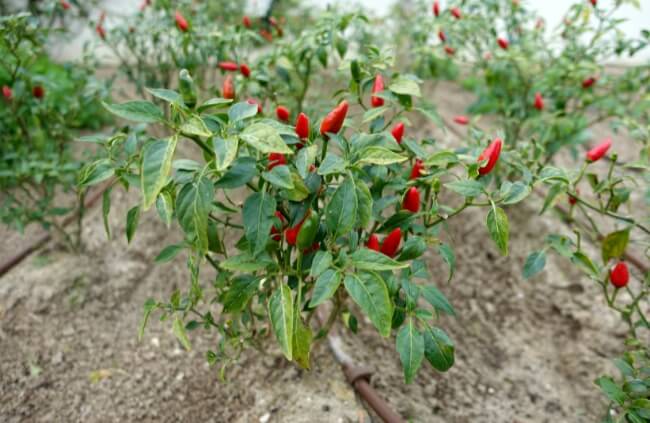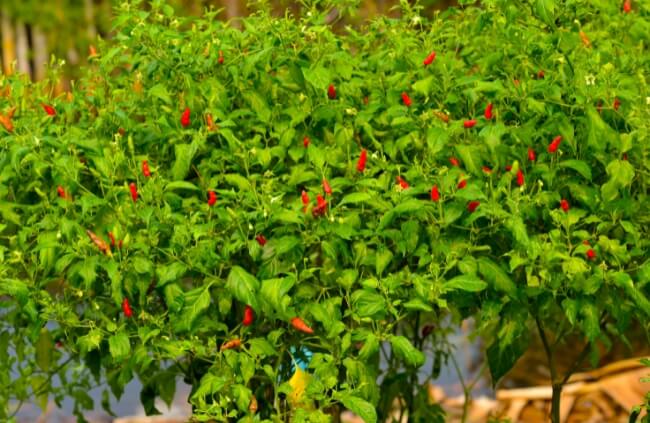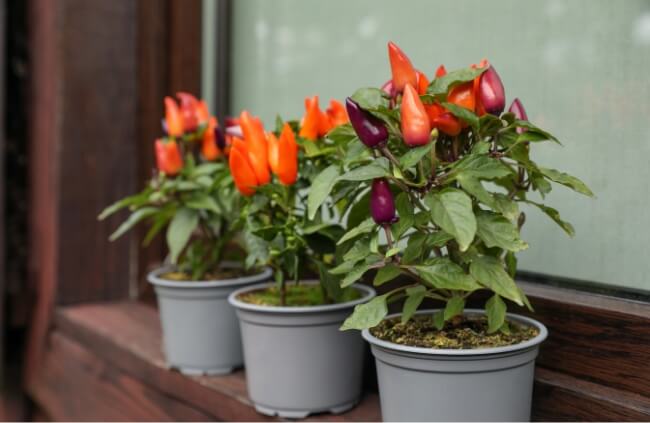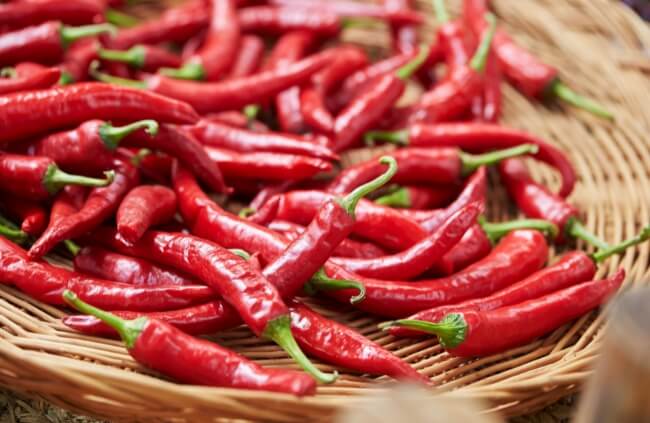Anyone that likes spicy dishes, loves chillies. Chillies are a favourite food for many Australians and millions worldwide. The good news is that they are easy to grow, are a versatile ingredient for cooking, and are good for your health.
Originating in Central and South America, chilli plants are well suited to Australian conditions. Chilli plants are incredibly versatile and can be grown indoors, in a greenhouse or out in the garden. They also work perfectly in container pots and are also very ornamental plants.
If you are wondering how to grow chillies, here is everything you need to know to cultivate, care for and grow chillies at home.
More...
Botanical name: | Capsicum annum |
|---|---|
Botanical family: | Solanaceae (Nightshade) |
What are Chilli Plants?

Also sometimes known as ‘hot peppers’, chillies are famous for their sometimes tongue burning flavour. However, not every variety brings a tear to the eye. The higher the level of capsaicin, a compound concentrated in the seeds and adjacent fleshy sack, the hotter the chilli.
All chilli pepper fruit starts green and as they mature, they change colour. Chillies get hotter as they ripen. Chillies boast high levels of Vitamin C and antioxidants. Regular consumption has been linked to weight loss, combating inflammation and numerous other health benefits.
Chillies are a warm-season plant, which you can grow almost all year round, in tropical and subtropical parts of Australia. However, they don’t tolerate frost. In temperate climate zones of Australia, they are more successfully grown as annuals.
Best Chillies to Grow in Australia
If you are interested in growing chillies at home, there are several chilli plants readily available in Australian nurseries and garden centres.
What you choose to grow really depends on how hot you like your chillies and their heat rating. Some of the most common varieties you might consider include:
- Cayenne – Long, glossy, sharply pointed, red or green chillies. Very versatile and often used in stir-fries and on pizzas
- Jalapeno – Chunky, green chilli, commonly used in Mexican dishes. Generally medium heat. (Refer to our jalapeno growing guide for more details.)
- Habanero – A very hot, bell-shaped fruit, which ranges in colour from light green to orange pink at maturity.
- Bird’s Eye or Thai – A small, spicy, chilli that ripens from green to red. Regularly used in Asian cuisine, stir fries and curries.
There are over 4,000 varieties of chilli in the world, so there is plenty of scope to seek out and grow a chilli that matches your taste buds perfectly.
How to Grow Chillies in Australia

Where to Position Chilli Plants?
Chilli plants should be positioned in a warm, sunny part of the garden. They love the heat! If you can put them in a somewhat sheltered spot that gets full sun, your chilli plants will do well. Given their shallow root structure, try and protect them from the wind.
Position your chilli plants in a spot where they will receive at least 6 hours of sun each day. Chillies will grow in part sun, but this isn’t ideal, and you’ll end up with a leggy plant.
If you are planting your chillies in the garden, avoid planting them where hungry crops have been grown previously.
Growing Chillies from Seeds
Chilli plants can be purchased as seedlings, established plants or can also be grown from seed. It is easiest to buy chillies as established seedlings but growing from seeds is cheaper and gives you access to more varieties of chilli plants.
So how do I grow chillies from seed? You need heat to successfully grow chillies from seed. Needing at least 20°C to germinate, the best time to sow seeds, in most parts of Australia, is early spring.


Get Your Free Guide:
Master Growing Australian Natives eBook
A Must Have Complete Guide for Every Australian Garden
Get Your Free Guide:
Master Growing Australian Natives eBook
A Must Have Complete Guide for Every Australian Garden
Start growing your chilli seeds off indoors by propagating in seed trays. Sow seeds in individual cells no more than 1 cm deep, cover with a good seed raising soil mix and then add some moisture. Note that you can also sow seeds directly into the garden, but you don’t have any control over temperature, and they are very vulnerable when small.
Don’t let the soil mix dry out. Try to keep it moist to the touch but not wet. Using a small water mister is a good idea rather than drowning the seeds by pouring water directly onto them. Keep them warm. If you have them outside during the day, make sure to bring the seed tray in at night.
Germination usually takes just over 1 week. Leave them in the seed tray until they have sprouted their first set of leaves. Discard any weak looking plants and only pot the strongest ones.
Aim to transplant your chillies to pots when daytime temperatures are around 20°C or warmer. Water the chilli plant before transplanting so that the soil doesn’t fall apart and disturb the roots too much. Be careful.
Growing Chillies in Pots

Growing chillies in pots is probably the easiest way to grow chillies in Australia. It especially makes sense for people with small gardens or just a balcony.
Growing chillies in container pots is also a sensible approach in cooler areas of Australia as it gives you the flexibility to move the plant to a more protected area of your home if you’re expecting frost.
To successfully grow chilli in a container pot you need to ensure you have rich, fertile soil. Use a high-quality premium potting mix or garden soil and some compost for best results. If the soil is poor, you will need to add some fertiliser.
Chilli plants don’t like to be transplanted and hate having their roots disturbed, so choose a suitable pot size upfront. It is recommended that you use a container that is at least 30 cm wide and offers good drainage. You can go larger, especially if you live in warmer parts of Australia.
There isn’t a need to put a saucer under the pot. It’s far more advisable to water regularly. Depending on the weather you’ll need to water your seedlings about 2-3 times per week for the first month.
When the plant gets to about 15cm, try clipping or pinching the growing tip. This will result in a fuller, bushier plant. Also, remove any flowers that appear early in the plant’s growth.
How to Care for Established Chilli Plants
Chillies love heat and should be in the hottest part of your garden. As a result, you will need to water regularly and consistently. Make sure that your chillies never dry out, but also avoid overwatering. They don’t like to sit in swamping soil so make sure it is free draining.
For established chilli plants, give them at least one good soaking per week to encourage stronger root development. Adding mulch, such as pea straw or lucerne hay, will also help.
Another factor to consider is that chilli plants have shallow, weak roots. Given this, it is a good idea to provide support to your younger chilli plants, by adding a stake that should prevent the plant from toppling over in a strong wind or when it becomes top-heavy.
Chilli plants also have weak branches, and when they grow lots of fruit, these branches can easily snap. Either give them some support or cut off the broken branches and new ones will grow.
If you have planted chillies in good soil, they shouldn’t need much fertiliser to thrive. In fact, over-fertilising your chilli plants will lead to more foliage, but less fruit. Make sure to fertilise when the fruit first begins to appear. Avoid fertilisers high in nitrogen. Chilli plants generally don’t require pruning.
Chilli Plant Diseases
Generally, chillies don’t have many issues with disease or pests and are a fairly low maintenance plant. Some chilli plants are impacted by root-knot nematodes, where microscopic ringworms attack the roots and can cause the plant to wilt and die.
The best way to combat this is to add compost to the soil and for potted chilli, make sure you use a new potting mix every time you replant.
When to Pick Chillies

Chilli plants will flower and fruit around November through to April, depending on where you live in Australia. You can harvest the chilli fruit whenever the fruit has grown to a decent size. This is normally by mid to late summer.
At first, chillies will be green but If you wait the fruit will ripen and turn to yellow, orange or red, depending on the variety. The more mature the chilli, the stronger the flavour and hotter the chilli gets.
Regular harvesting of the fruit can stimulate more flowering and fruiting. The more fruit you remove, the more chillies you will produce. Chilli plants are generally productive for many months.
You can pick the fruit off by hand, by pulling it upwards, which will snap it off at the joint and not break the branch. Alternatively cut off the fruit.
Chilli Plant Frequently Asked Questions
How long do chillies need to grow?
Chilli plants grow quickly. There are lots of different varieties of chilli plants, but it typically takes between 3-4 months for the fruit to be ready to harvest. How quick they are to fruit also depends on the temperature.
How long do chilli plants live?
How long your chilli plant lives really depends on where you live in Australia. They are typically an annual plant. Chilli plants can perform as a perennial in warmer parts of Australia, but they will need a good cut back after harvesting the fruit.
Now You Know How to Grow Chillies
Chillies are rewarding plants to grow, regardless of the variety you choose to grow and whether you use the fruit for cooking or simply want an ornamental plant.
You should be able to grow chillies in a pot or your veggie patch with little problems, provided they get lots of sun and the right amount of watering. Feel free to reach out If you have any questions about how to grow chillies in Australia.
Published on August 24, 2023 by Gary Clarke
Last Updated on January 21, 2025




